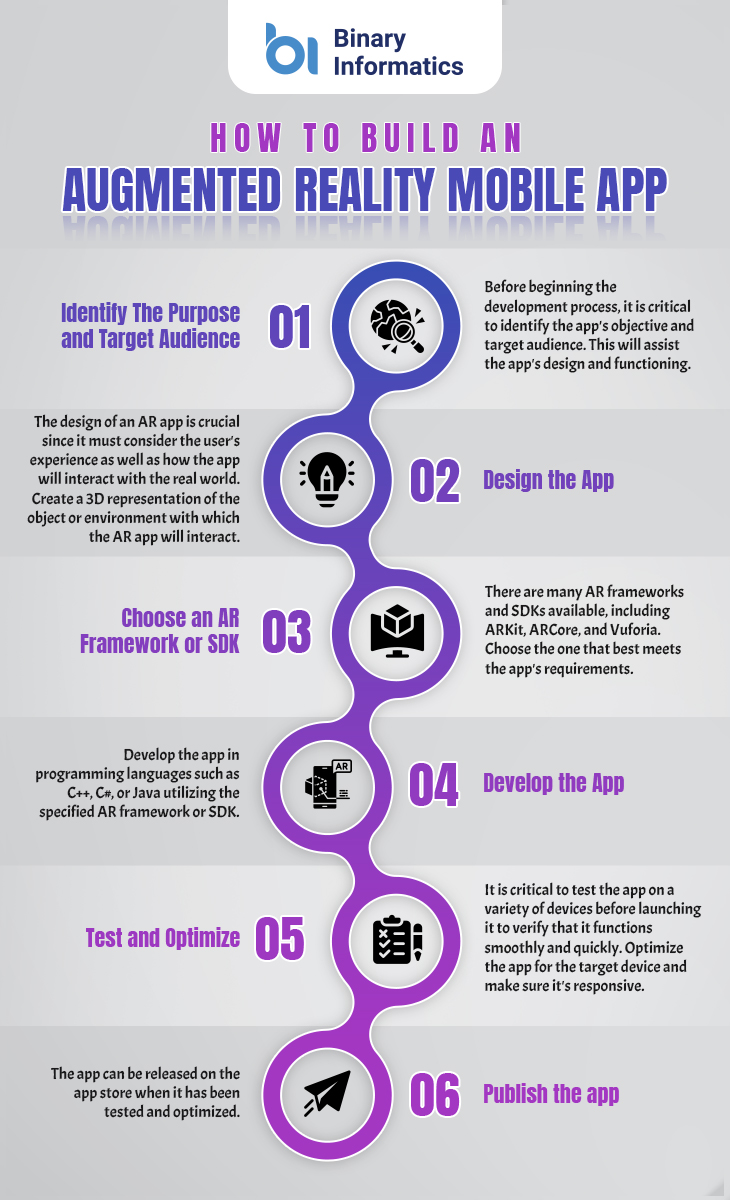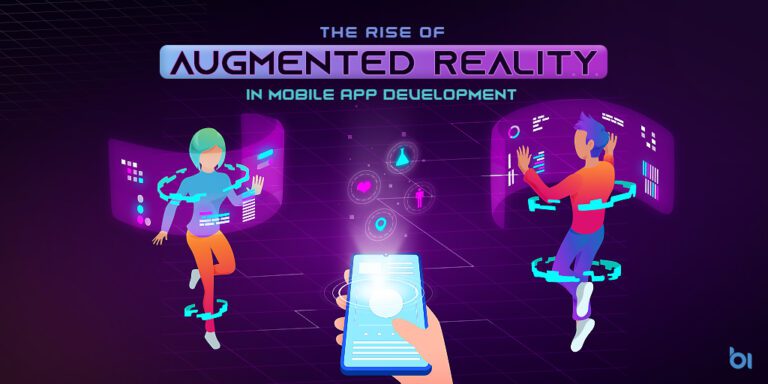The increased availability of powerful smartphones and tablets and the development of his ARKit and ARCore for iOS and Android respectively have made it easier for developers to create his AR apps. In this article, we examine the rise of AR in mobile app development, its impact on various industries, and the future potential of this technology.
Table of Contents
ToggleHow To Build an Augmented Reality Mobile App

Building an AR mobile app can be a complex process, but it is not impossible. Building an augmented reality mobile app requires a few key steps:
Identify The Purpose and Target Audience
Before beginning the development process, it is critical to identify the app’s objective and target audience. This will assist the app’s design and functioning.
Design the App
The design of an AR app is crucial since it must consider the user’s experience as well as how the app will interact with the real world. Create a 3D representation of the object or environment with which the AR app will interact.
Choose an AR Framework or SDK
There are many AR frameworks and SDKs available, including ARKit, ARCore, and Vuforia. Choose the one that best meets the app’s requirements.
Develop the App
Develop the app in programming languages such as C++, C#, or Java utilising the specified AR framework or SDK.
Test and Optimize
It is critical to test the app on a variety of devices before launching it to verify that it functions smoothly and quickly. Optimize the app for the target device and make sure it’s responsive.
Publish the app
The app can be released on the app store when it has been tested and optimised.
When developing an augmented reality mobile app, it is equally important to consider the user’s privacy and security. This can contain features like user authentication and data encryption. Furthermore, developers should consider the user’s interactions with the app, such as touch and gestures.
Augmented Reality (AR) in Mobile App Development
Augmented reality (AR) technology is gaining popularity in app development. AR is a technology that augments the user’s perception of the actual world. By overlaying digital data on the perspective of the physical world. This technology is used in a variety of industries, including gaming, education, entertainment, and e-commerce.
AR technology is used in app development to provide immersive and interactive experiences for users. In gaming apps, for example, AR can be used to create virtual worlds that users can explore and interact with.
AR can be utilized in education apps to create interactive courses that make learning more interesting and fun. It can be used in entertainment apps to provide interactive experiences such as virtual tours and movie screenings.
AR can be used in e-commerce apps to offer virtual try-on experiences for things like clothing and makeup.
Software Requirements for AR
In order to create an AR mobile app, you must first grasp the software requirements for AR. The first prerequisite is a solid understanding of programming languages like Java or C++.
You should also be familiar with AR development technologies such as Unity or Vuforia. You will also need to be familiar with 3D modelling and animation applications such as Maya or Blender.
Designing an AR Mobile App
Designing an AR mobile app involves not just building a visually stunning app. But also creating an app that is simple to use and understand. The key to designing an AR mobile app is to keep the user experience in mind.
When it comes to the user interface, it is essential to keep things basic and straightforward. The app should allow the user to quickly navigate and find the information they require. It is also important to utilize clear and simple wording when presenting the app’s various features.
Implementation of AR in Mobile App Development
There are various ways to include augmented reality in smartphone apps. Using AR to enhance the gaming experience, give instructional content, or deliver healthcare information are some of the most common applications.
Gaming is one of the most popular uses of AR in mobile apps. AR can be used to improve gaming by allowing players to engage with the game in a more immersive manner.
A game, for example, may use augmented reality to display a virtual character on the screen, allowing the user to interact with the figure in a more realistic manner.
Another popular way to use AR in mobile apps is in education. AR can be used to provide educational content in a more interactive and engaging way. For example, an educational app might use AR to display virtual objects on the screen, allowing the user to interact with the objects in a more realistic way.
Finally, AR can also be used in healthcare. For example, an app might use AR to provide information about a medical condition, such as how to diagnose and treat the condition.
The Technology Used in Augmented Reality
The technology used in augmented reality (AR) includes both hardware and software components.
Hardware components include:
- Cameras: AR apps use the camera of the device to capture the real-world environment and overlay digital information on it.
- Sensors: AR apps use various sensors such as accelerometers, gyroscopes, and GPS to track the movement and position of the device.
- Displays: AR apps use the device’s display to show the augmented reality view to the user.
Software components include:
- AR frameworks and SDKs: AR frameworks and SDKs provide developers with the tools and resources they need to create AR apps for iOS and Android devices. Examples of popular AR frameworks include ARKit, ARCore, and Vuforia.
- 3D modeling software: Developers use 3D modeling software such as Autodesk Maya or Blender to create 3D models of the objects or environments that the AR app will interact with.
- Programming languages: Developers use programming languages such as C++, C#, and Java to create the AR app.
- Computer Vision Algorithms: to identify and track objects in the real world, AR apps use computer vision algorithms that allow the device to understand its surroundings.
- Artificial Intelligence and machine learning: these technologies are used to create more realistic and interactive experiences in AR apps.
Overall, the technology used in augmented reality is a combination of various hardware and software components that work together to create an immersive and interactive experience for the user.
With the help of AR frameworks and SDKs, 3D modeling software, programming languages, computer vision algorithms, and artificial intelligence and machine learning, developers can create AR apps that are able to understand and interact with the real world.
Conclusion
In conclusion, the rise of AR in mobile app development has opened up a whole new world of possibilities for mobile app developers. With the ability to combine the real world with digital elements, AR has the potential to change the way we interact with mobile apps in a wide range of industries.
To build an AR mobile app, developers must have a good understanding of the technology used in AR, including the camera, display, and processor. They must also have a good understanding of programming languages, AR development tools, and 3D modeling and animation software.
Implement AR in mobile apps, developers can use it to enhance the gaming experience, provide educational content, or provide healthcare information.
To design an AR mobile app, developers must keep the user experience in mind, creating a simple and easy-to-use interface with clear and concise language.
With the rise of AR in mobile app development, the future looks bright for this exciting technology.




